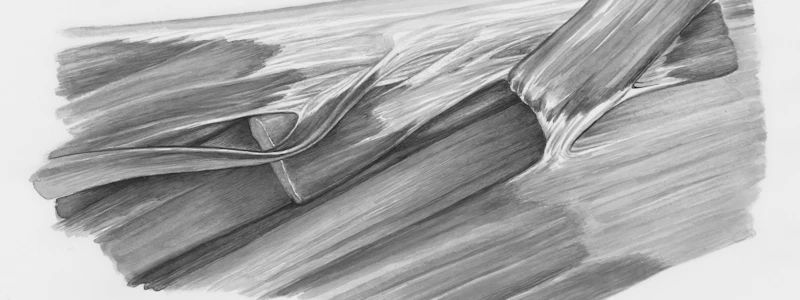Podcast
Questions and Answers
Which of the following movements involves a combination of flexion, adduction, extension, and abduction at a joint?
Which of the following movements involves a combination of flexion, adduction, extension, and abduction at a joint?
A movement that decreases the angle between two bones is called:
A movement that decreases the angle between two bones is called:
Based on the text, what is the primary purpose of the opposition movement?
Based on the text, what is the primary purpose of the opposition movement?
Which of the following movements demonstrate a non-angular motion?
Which of the following movements demonstrate a non-angular motion?
Signup and view all the answers
Which of the following movements involves the forearm rotating laterally so that the palm faces anteriorly?
Which of the following movements involves the forearm rotating laterally so that the palm faces anteriorly?
Signup and view all the answers
The movement of the toes pointing downward is called:
The movement of the toes pointing downward is called:
Signup and view all the answers
Which of the following describes the movement of the ankle when the foot is inverted?
Which of the following describes the movement of the ankle when the foot is inverted?
Signup and view all the answers
What is the evolutionary significance of the opposition movement?
What is the evolutionary significance of the opposition movement?
Signup and view all the answers
Which of the following movements is NOT an example of an angular movement?
Which of the following movements is NOT an example of an angular movement?
Signup and view all the answers
The movement of the humerus away from the midline of the body is called:
The movement of the humerus away from the midline of the body is called:
Signup and view all the answers
Which of the following bodily structures exhibit gliding movement?
Which of the following bodily structures exhibit gliding movement?
Signup and view all the answers
Which of the following joints allows for medial and lateral rotation?
Which of the following joints allows for medial and lateral rotation?
Signup and view all the answers
What type of movement does the movement between the atlas and axis vertebrae belong to?
What type of movement does the movement between the atlas and axis vertebrae belong to?
Signup and view all the answers
Study Notes
Types of Movements
- Three basic types of movement exist: angular, rotational, and gliding.
Angular Movements
- Angular movements increase or decrease the angle between bones.
- Movements include flexion, extension, abduction, adduction, and circumduction.
- Flexion decreases the angle, extension increases the angle.
- Abduction moves a limb away from the midline, adduction moves it towards the midline.
- Circumduction is a combination of flexion, extension, abduction, and adduction.
Rotational Movements
- Rotation is a turning movement around a bone's long axis.
- Examples include the movement between the atlas and axis vertebrae.
- Rotation also occurs at the hip and shoulder joints.
- Medial and lateral rotations are distinct types of rotational movements.
Gliding Movements
- Gliding movements occur when flat surfaces of two bones slip across each other.
- Gliding movements typically occur between carpals, tarsals, and the articular processes of vertebrae.
Special Movements
- Supination: Forearm rotates laterally, causing the palm to face anteriorly.
- Pronation: Forearm rotates medially, causing the palm to face posteriorly.
- Dorsiflexion: The top of the foot moves toward the shin.
- Plantarflexion: The toes are pointed downward.
- Inversion: The foot rolls inward (medially).
- Eversion: The foot rolls outward (laterally).
- Protraction: Non-angular movement, jutting the jaw outward.
- Retraction: Opposite of protraction, moving the jaw back.
- Elevation: Lifting something superiorly.
- Depression: Moving something inferiorly.
- Opposition: Thumb touches other fingertips—necessary for grasping and manipulation.
Studying That Suits You
Use AI to generate personalized quizzes and flashcards to suit your learning preferences.
Related Documents
Description
Test your knowledge on various joint movements and their terminology in this comprehensive quiz. Explore the definitions of flexion, extension, and other movement types while understanding their evolutionary significance and applications. Perfect for students studying anatomy and kinesiology.





